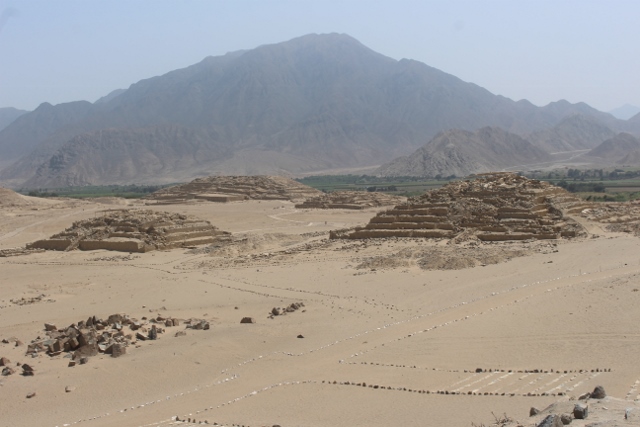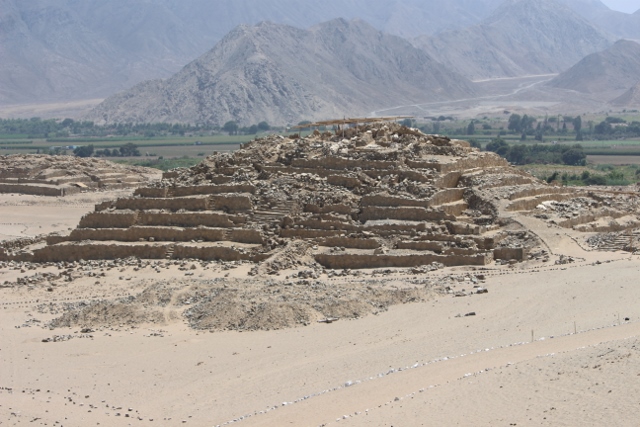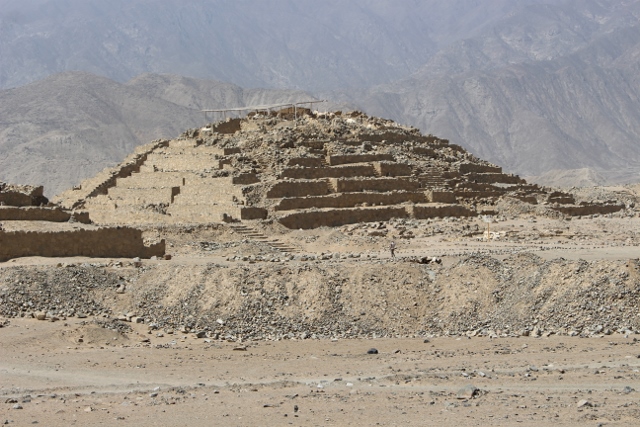The ruins of Caral are the most ancient archaeological finds in Peru, by far. Against our expections, they proof to be spectacular.
Barranca is another one of these small coastal town that have not much of interest. Earlier we perhaps could have enjoyed the beach, but the season is over, and almost everything along the boulevard is closed. Yet, the centre has a pleasant enough atmosphere to establish ourselves for a couple of days. But we are not here for Barranca, we are here for the archaeological site of Caral, by far the oldest in Peru.
The road to Caral, an unsurfaced road branching off the Panamericana, follows the Supe River, through an attractive valley. Lots of agricultural production, from sugar cane to maize; fruit trees everywhere, and passion fruit plants blooming. A little further back, there are several lesser pyramids and other structures being unearthed, all part of the Caral culture, and subordinate to the royal complex we are heading for.
Although the site has been mentioned in earlier records, it was only properly explored in the late 1990s, by an archaeologist who, using aerial photographs, decided that the six stone hills she observed could possibly be man-made, rather than natural. So she started digging, and unearthed six stone pyramids, dating back some 5000 years ago, so long before the Moche and the Chimu cultures, long before the – inferior – adobe pyramids we have seen in around Chiclayo and Trujillo. 5000 years ago, that is time-equivalent with Mesopotamian civilisations, and Egypt’s pyramids.
We didn’t have a lot of expectations: a site not very well known, even though it is relatively close to Lima, the unsurfaced access road, absence of tour buses. But what’s attractive is that our 10 year old guide book mentions that here, at last, we could wander around freely, could climb the pyramids, unconstrained by ropes outlining what is out-of-bounds, and instead directing the prescribed route, the path. Finally, Indiana Jones revisited!
Not so, anymore. However much we argue, you can only enter the site with a guide, one who makes sure you do NOT climb the pyramids, do NOT wander around freely, and furthermore tries every trick to shortcut our tour as much as possible. From a distance we already noticed that we may have to readjust our expectations. The many different buildings stretch over a large area, and they look absolutely fascinating from afar. “Ah, senor, una hora, no mas” – one hour, no more, according to the guide. To cover this vast area, look at each and every construction, around each and every corner? Even without climbing the pyramids that is not going to be enough.
One reason that these pyramids have been kept so well, is that when they were abandoned, around 1800 BC, they were filled in and covered with rocks, so that from the outside they were unrecognisable. (Another reason maybe that they now don’t allow tourists to climb the pyramids anymore!) On site, several people are working to unearth more and more from the structures, the six pyramids in a large circle and several ceremonial platforms, an amphitheatre, residential dwellings and other pieces of construction. Our guide, in fact, turns out to be a nice guy, although he gets exhausted by the very many deviations from the official route we propose. At one stage I get told off by somebody else on the site, because I have drifted too far away from my guide: no amount of ingenuity is going to help, here! In the end we spend a good two hours, all on the official paths, thoroughly enjoying this impressive complex.
next: Lima, finally







































